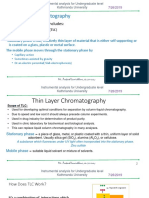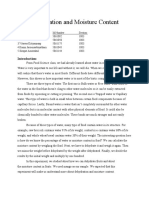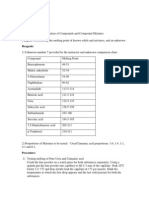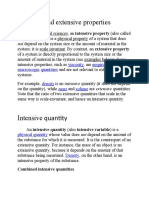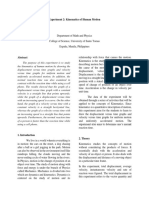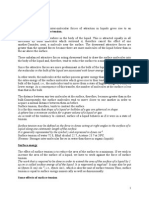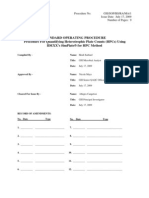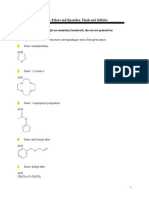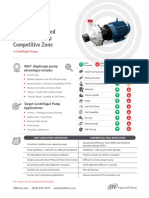Physical Properties of Liquids
Physical Properties of Liquids
Uploaded by
SubhamshaCopyright:
Available Formats
Physical Properties of Liquids
Physical Properties of Liquids
Uploaded by
SubhamshaCopyright
Available Formats
Share this document
Did you find this document useful?
Is this content inappropriate?
Copyright:
Available Formats
Physical Properties of Liquids
Physical Properties of Liquids
Uploaded by
SubhamshaCopyright:
Available Formats
Surface tension The existence of strong inter-molecular forces of attraction in liquids gives rise to an important property: surface tension.
Consider a molecule somewhere in the body of the liquid. This is attracted equally in all directions by other molecules which surround it, therefore cancel the effect of one another.Consider, next, a molecule near the surface. The downward attractive forces are greater than the upward forces because there are more molecules of the liquid below than in the air above the surface. These unbalanced attractive forces acting downward tend to draw the surface molecules into the body of the liquid and, therefore, tend to reduce the surface to a minimum. Since the attractive forces are more predominant in the bulk of the liquid than at the surface, the molecules in the bulk of the liquid are associated with lower energy than at the surface. In other words, the molecules at the surface possess greater energy than those in the bulk. It is the extra energy of the surface molecules which gives rise to their tendency to move into the bulk of the liquid, i.e., the molecules tend to move from a state of higher energy to a state of lower energy. As a consequence of this transfer, the number of molecules at the surface is less than that in the bulk. The distance between any two molecules at the surface, therefore, becomes greater than in the bulk.Consequently, the surface molecules tend to move closer to one another in order to acquire a normal distance between them as before. Surface tension, therefore, tends to contract the surface. It is for this reason that drops of a liquid or bubbles of a gas are spherical in shape. A sphere has a minimum surface for a given volume of a liquid or gas. As a result of the tendency to contract, surface of a liquid behaves as if it were in a state of tension. Surface tension may be defined as the force in dynes acting at right angles to the surface of a liquid along one centimeter length of the surface. It is generally represented by the symbol and expressed in dynes cm-1. Surface tension of water 72.8, Ethyl alcohol 22.7, Acetone 23.7 at 20C. (Reason- Stronger inter-molecular forces in water than those in organic liquids) Surface energy The effect of surface tension is to reduce the area of the surface to a minimum. If we wish to increase the area of the surface of a liquid, we have to work against the force of surface tension.
The work that is required to be done in order to extend the area of the surface of a liquid by 1 sq.cm.is called surface energy of of the liquid . It is expressed in ergs/cm2. It may also be put as (dynes X cm) cm -2, i.e., dynes cm-1, which is also the unit of surface tension.Thus; surface tension is equal to surface energy numerically as well as dimensionally. Some effects of surface tension 1. The effect of surface tension is to reduce the area of the surface to a minimum. Hence drops of a liquid or bubbles of a gas are spherical in shape as stated before. A sphere has a minimum surface for a given volume. 2. The rise of a liquid in a capillary tube(e.g., rise of oil in the wick of a lamp, rise of under-ground water on to the surface of earth) Capillary rise method A method of measuring surface tension Consider a capillary tube lowered in a liquid that wets its surface (e.g., water).The liquid will rise almost instantaneously up to a certain height depending upon its surface tension and density. The column of the liquid in the capillary is, evidently, being supported by some force acting along the surface of the water. This is force of surface tension. Suppose a liquid of density d, rises in a capillary tube of radius r, through a height h. Let be the force of surface tension in dynes per cm. Then, the total force due to surface tension, raising the liquid column upward = x inside circumference of the capillary, i.e., = 2 r dynes. Force of gravity pulling the liquid downward = weight of the liquid column. Weight of the liquid in the column = v dg dynes where v is the volume of the liquid in the tube. But v = r2h. Hence, for equilibrium, 2 r = r2 h dg = r h dg/ 2 dynes per cm. It is assumed in the above derivation that the contact angle between the glass and the liquid is zero, that is, wetting is perfect. If this is not so, it can be shown that = r h dg/ 2cos This gives us, incidentally, a method of measuring surface tension, known as the capillary rise method. For this purpose, it is required to measure the height (h) through which the liquid rises and the radius(r) of the capillary tube, both in cm.The height is measured by a cathetometer and the radius of the capillary tube by a traveling microscope. The contact angle in most such cases is zero. The Drop Weight Method In physical chemistry, surface tension is usually measured by the drop weight method as this is more convenient. This method is based on the principle that the weight (w) of a
drop of liquid, falling from a given capillary tube held vertically is approximately proportional to the surface tension of the liquid. Thus, if surface tensions of any two liquids are 1 and 2, then, 1 / 2 = w1/w2 Where w1 and w2 are mean weights of their drops falling from the same capillary tube. The instrument used is known as stalagmometer. It is more convenient to count the number of drops formed by a given volume of a liquid than to find the weight of a drop. Suppose, equal volumes (V) of two liquids, when allowed to fall through the same stalagmometer, form n1 and n2 drops. Then, mean weights of such drops w1 and w2 are given as: w1 =V d1/n1 w2 =V d2/n2 Where d1 and d2 are densities of the two liquids. Hence 1 / 2 = w1/w2 = V d1/n1 / V d2/n2 = n2d1 /n1d2 If surface tension of one of the liquids is known, that of the other can be easily calculated. The densities of the liquids may be determined by the usual specific gravity bottle or pyknometer method. Procedure The stalagmometer is first thoroughly cleaned with chromic acid mixture and dried. It is then filled with water up to the mark M by sucking at the other end of the tube. The water is then allowed to come out in the form of drops which are counted. The number of drops per minute should not exceed 20 as otherwise they will not be properly formed. The rate can be controlled with the help of a pinch cock attached to a rubber tube at the upper end of the stalagmometer. The stalagmometer is again thoroughly washed and dried and now filled with the liquid under examination upon the same mark M. The number of drops is counted as before. Let the number of drops of water and the liquid under examination be n1 and n2 and let d1 and d2 be their respective densities. Then, surface tension of the liquid, n2d1 2 /n1d2, where 2 is the surface tension of water at the same temperature. Interfacial Tension Suppose, two immiscible liquids are present one above the other in a vessel. Then, the force acting per unit length along the interface is called interfacial tension. This is less than the surface tension of the liquid with a higher value. The reason is that the unbalanced forces acting along the surface of each liquid are partly compensated by force of mutual attraction between the molecules of the two liquids.
It may be emphasized that surface tension and interfacial tension involve the same type of force. When one speaks of surface tension of a liquid, it is understood that the force is acting along the surface of separation between the liquid and its vapour.When one speaks of interfacial tension, it is understood that the force is acting along the surface of separation of two immiscible liquids in contact with each other. Effect of temperature on surface tension According to the kinetic theory, molecular kinetic energy is proportional to absolute temperature. The rise in temperature of a liquid, therefore, is accompanied by increase in energy of its molecules. The intermolecular forces of attraction, therefore, decrease with rise in temperature. Hence surface tension of a liquid decreases with rise in temperature. At critical temperature, since the surface of separation between a liquid and its vapour disappears, the surface tension falls to zero. Eotvos found that surface tension varies linearly with temperature. He suggested that the following expression for the variation of surface tension with temperature: (M/d) 2/3 = a k t Where M is the molecular weight the density and the surface tension of the liquid at the temperature t; a and k are constants. M/d , evidently, is molecular volume of the liquid. Assuming this volume to be spherical (since area of a sphere is minimum), we may take (M/d) 2/3 as proportional to the molecular surface of the liquid. Since , the surface tension, is also surface energy per square centimetre, it is evident that the expression (M/d) 2/3 is proportional to molecular surface energy. At the critical temperature (i.e., when t = tc) the surface tension is zero. Substituting these values we may write 0 = a- k tc a = k tc Therefore The Eotvos equation, therefore, may be written as: (M/d) 2/3 = k (tc t) This equation has been found to be satisfactory in giving variation of surface tension with temperature in the case of a number of liquids over a wide range of temperature. Surface Active Agents
A number of substances are known which, when added to water, lower its surface tension. These substances are called surface active agents. Thus liquids like methanol, ethanol, acetone and acetic acid when added to water lower its surface tension. Salts of higher sulphonic acids and higher amines which behave in this manner. They are all surface active materials. These substances act as detergents. To take an example, we may explain the action of soap as a detergent. Most of the dirt or dust sticks on to grease or oily materials which somehow gather on cloth. As grease is not readily wetted by water, it is difficult to clean the garment by water alone. The addition of soap lowers the interfacial tension between water and grease so as to facilitate the mixing of the two. The soap molecules get oriented at the interface between water and oil (or grease) in such a way that their polar end (-COONa) is dipping in water and the hydrocarbon chain(R-) in the oil. This helps in bringing the two liquid phases in more intimate contact with each other. In other words , the presence of soap causes emulsification of grease in water. The mechanical action, such as rubbing, etc., releases the dirt. Viscosity Viscosity implies resistance to flow. It is well-known that all liquids do not flow equally readily. Those liquids which flow slowly(for example,glycerine,castor-oil,honey and coal- tar) are said to have high viscosity while those which flow readily(for example,water,alcohol and ether) are said to have low viscosity. The significance of viscosity may be further elucidated by considering the flow of a liquid through a narrow pipe. All parts of the liquid do not move with the same velocity. A thin layer, immediately in contact with the walls of the tube, is almost stationary. Each succeeding thin layer of the liquid moves with gradually increasing velocity which becomes maximum as the centre of the tube is approached. The resistance that one part of a liquid flowing with one velocity offers to another part of the liquid flowing with a different velocity is known as viscosity. Alternatively, viscosity may be looked upon as the force of friction between two layers of a liquid moving past one another with different velocities. Suppose a cylindrical liquid layer of area A sq.cm. moves over another similar layer at a distance of S cm.with a velocity difference of u cm.per sec.Then, the tangential force of friction (f), required to maintain a constant difference of velocity, is given by f = Au/S
Where is a constant at a given temperature, depending upon the nature of the liquid and is known as the coefficient of viscosity. If A is 1 sq.cm., u is 1 cm.per sec. and S is 1 cm., then f = . The coefficient of viscosity of a liquid may, therefore, be defined as the force in dynes per square centimetre required to maintain a difference of velocity of 1 cm.per sec. between two parallel layers of the liquid held at a distance of 1 cm. from one another.
The reciprocal of viscosity is called fluidity and denoted by . Thus = 1/
Determination of Viscosity There are a number of methods of different kinds for measuring viscosity. The method commonly employed is based on poiseuilles law which connects the rate of flow of a liquid through a capillary tube with the coefficient of viscosity of the liquid and is expressed by the equation: = r4 t p / 8 V l
Where V is the volume in c.c.of the liquid flowing in t seconds through a narrow tube of radius r cm. and length l cm.under a hydrostatic (driving) pressure of p dynes per square centimetre and is the coefficient of viscosity in poises(i.e., dynes per square centimeter). Since the hydrostatic pressure p of a liquid column is given by P = hdg Where h is the height of the column and d the density of the liquid, the poiseuilles equation may be written as: = r4 t h d g / 8 V l
It is not necessary to measure all quantities on the right hand side of the above equation. The viscosity of water at different temperatures has been very accurately determined. The usual procedure is to determine the viscosity of a liquid with reference to that of water. This is termed as relative viscosity. All that is done is to measure the times of flow for equal volumes of water and the liquid under examination, through the same capillary. If t1 and t2 are the times of flow of the same volume of water and the liquid, respectively, and 1 and 2 are the respective coefficients of viscosity, then 1/ 2 = r4 t1 h d1 g 8 V l X 8 V l r4 t2 h d2 g The value of h is the same in both cases since equal volumes of both liquids are taken and, therefore, they stand at the same height. Therefore, 1/ 2 = d1 t1 / d2 t2
Oswalds Viscometer
Oswalds viscometer is used for measuring viscosity by the above method. It is first thoroughly cleaned with chromic acid mixture and dried. A known volume of water, usually 10 to 25 ml.depending upon the capacity of the bulb A, is pipetted into the bulb B( bulb B is bigger than A).It is then sucked into the bulb A with the help of a rubber tube attached at the end C till it rises to the mark M. The time taken by this water to flow through the capillary tube DE is noted by means of a stop watch. Let it be t 1.The viscometer is dried and the same volume of the liquid under examination is taken into the bulb B (so that the pressure head remains the same) and the process repeated as before. Let the time of flow now be t2.Then, evidently, 1/ 2 == d1 t1 / d2 t2 Where d1 and d2 are the densities of the two liquids which can be determined by specific gravity bottle or by pyknometer method. Knowing the coefficient of viscosity of water ( 1), that of the other liquid ( 2) can easily be calculated. Unit of viscosity As we have equation, = f S/Au
Since f is measured in dynes, S in cm. A in cm. 2 and u in cm./sec., Hence the units of are dynes x cm. / cm.2 x cm./sec. = dynes cm.-2sec.Thus viscosity is measured in dynes sec. /cm2. For simplicity, the units of viscosity dynes sec.cm-2 are called poises. Still more convenient units of viscosity are centipoises and millipoises (one millipoise = 0.001 poise and one centipoise = 0.01 poise). Glycerine has high viscosity because of the formation of a network of hydrogen bonds between the molecules. The network which extends throughout the liquid makes the flow difficult. Effect of temperature on viscosity With rise in temperature, kinetic energies of molecules increase. The inter-molecular forces of attraction.therefore.decrease.Hence,like surface tension, viscosity of a liquid also decreases with rise in temperature. The effect of temperature on viscosity is, however, much greater than on surface tension. In most cases, the viscosity of a liquid falls by about 2 percent per degree centigrade rise of temperature. The variation of viscosity with temperature is best expressed by the empirical equation: = A eE / RT Where A and E are constant for a given liquid,R is the Universal gas constant and T is the temperature on absolute scale.
You might also like
- Lab Report 1 Diffusion Across Biological Membrances SimulationDocument7 pagesLab Report 1 Diffusion Across Biological Membrances SimulationAmeena Ali50% (2)
- Report BacteriaDocument11 pagesReport BacteriaSuzeanni JalilNo ratings yet
- Transport Properties of The Gas (Physical Chemistry 2)Document29 pagesTransport Properties of The Gas (Physical Chemistry 2)Adilla Rizka Yonita100% (1)
- Cargo Calculations On Tankers With ASTM Tables: Here Is All You Need To KnowDocument25 pagesCargo Calculations On Tankers With ASTM Tables: Here Is All You Need To KnowPanagiotis Mouzenidis100% (1)
- Hypothesis Test and Significance LevelDocument27 pagesHypothesis Test and Significance LeveltbhumuytjNo ratings yet
- What Is Activation OverpotentialDocument1 pageWhat Is Activation OverpotentialMuhammad RiaanNo ratings yet
- Presentation On Fick's LawDocument7 pagesPresentation On Fick's Lawhmth001100% (1)
- Archimedes PrincipleDocument8 pagesArchimedes Principleplantzombie12No ratings yet
- Introduction To Chemistry and MatterDocument81 pagesIntroduction To Chemistry and MatterQueenie Faith LaparNo ratings yet
- Laboratory Experiment No. 11 - Transport Across MembranesDocument4 pagesLaboratory Experiment No. 11 - Transport Across MembranesMary Rose CatalbasNo ratings yet
- SCIENTIFIC PAPER (Chemistry Lab) - Determination of DensitiesDocument4 pagesSCIENTIFIC PAPER (Chemistry Lab) - Determination of DensitiesMi Rivera75% (4)
- Purification of Acetanilide Via RecrystallizationDocument10 pagesPurification of Acetanilide Via RecrystallizationLouisiana Sollestre0% (1)
- Voltammetry and PolarographyDocument21 pagesVoltammetry and PolarographyMheira Villahermosa100% (2)
- This Study Resource Was: Analysis of Chemical Components of Milk Lab Report ObjectiveDocument6 pagesThis Study Resource Was: Analysis of Chemical Components of Milk Lab Report Objectiveapril hortilanoNo ratings yet
- Chapter 1 Unit and MeasurementDocument25 pagesChapter 1 Unit and MeasurementAmar Danial100% (1)
- CHEM 17 - Freezing Point of Naphthalene and Boiling Point Elevation of Water.Document8 pagesCHEM 17 - Freezing Point of Naphthalene and Boiling Point Elevation of Water.Gerry Mark GubantesNo ratings yet
- Research DesignDocument40 pagesResearch DesignBandita DattaNo ratings yet
- Experiment ChemDocument45 pagesExperiment Chemstanleylee100% (3)
- Food Analysis-5Document113 pagesFood Analysis-5MD. Humayun KobirNo ratings yet
- Planar ChromatographyDocument20 pagesPlanar Chromatographyramesh pokhrel100% (1)
- Experiment 2Document7 pagesExperiment 2glzlglzlNo ratings yet
- Determination of Solubility ClassDocument9 pagesDetermination of Solubility Classعلاوي البرشلونيNo ratings yet
- Colligative PropertiesDocument11 pagesColligative PropertiescorrigannolanNo ratings yet
- PotentiometryDocument7 pagesPotentiometrysuhanizah suhanizahNo ratings yet
- Notes - Mixtures and Pure SubstancesDocument32 pagesNotes - Mixtures and Pure Substancesapi-326942798No ratings yet
- Labreport 1Document6 pagesLabreport 1api-295869462No ratings yet
- Investegatory Project BiologyDocument15 pagesInvestegatory Project BiologyS JayasuriyaNo ratings yet
- Analytical ChemistryDocument26 pagesAnalytical Chemistryمحمد ناصر عليويNo ratings yet
- Line Spectra: Institute of Chemistry, University of The Philippines-Los BanosDocument5 pagesLine Spectra: Institute of Chemistry, University of The Philippines-Los BanosKimberly DelicaNo ratings yet
- 1180 Exp 04, Density and Specific GravityDocument13 pages1180 Exp 04, Density and Specific GravityShaniCoolestNo ratings yet
- Colligative Properties NotesDocument22 pagesColligative Properties NotesAbilash murali100% (1)
- Partition Coefficient of Benzoic Acid ExpDocument4 pagesPartition Coefficient of Benzoic Acid Expjaveria namoosNo ratings yet
- Fluid Flow Operations Lecture 1: Introduction: Dr. Srinivas Krishnaswamy Assistant Professor Chemical EngineeringDocument22 pagesFluid Flow Operations Lecture 1: Introduction: Dr. Srinivas Krishnaswamy Assistant Professor Chemical EngineeringPRAJWAL RASTOGINo ratings yet
- Glucose Assay by Dinitrosalicylic Colorimetric MethodDocument7 pagesGlucose Assay by Dinitrosalicylic Colorimetric MethodAbdullah Noordin50% (2)
- Immiscible Liquids and Steam DistillationDocument11 pagesImmiscible Liquids and Steam Distillationwaa_waaNo ratings yet
- Lab 1Document4 pagesLab 1Jason Robert VictorNo ratings yet
- Ch116L: Physical Chemistry (Laboratory) 1 Quarter SY 2019-2020Document8 pagesCh116L: Physical Chemistry (Laboratory) 1 Quarter SY 2019-2020John Andrae MangloNo ratings yet
- AbstractDocument10 pagesAbstractmarkNo ratings yet
- Experiment 6:water Quality Assesment-Solid QuatificationDocument4 pagesExperiment 6:water Quality Assesment-Solid QuatificationsandalailaNo ratings yet
- Chemistry Course OutlineDocument80 pagesChemistry Course OutlineJoric MagusaraNo ratings yet
- Intensive and Extensive PropertiesDocument10 pagesIntensive and Extensive PropertiesArvz Vash ArcadioNo ratings yet
- Mixing of LiquidsDocument35 pagesMixing of LiquidsmadhavNo ratings yet
- Exp Method StepsDocument5 pagesExp Method Stepskankshi ChopraNo ratings yet
- Principles of FTIR SpectrosDocument6 pagesPrinciples of FTIR SpectrosYen Ling NgNo ratings yet
- Membrane SeparationDocument13 pagesMembrane SeparationSharing Caring50% (2)
- Lecture 1 Surface and Interfacial PhenomenaDocument26 pagesLecture 1 Surface and Interfacial Phenomenabattal eduNo ratings yet
- Lab ReportDocument7 pagesLab ReportAristotle LeventidisNo ratings yet
- Experiment 2: Kinematics of Human MotionDocument5 pagesExperiment 2: Kinematics of Human MotionKat DinoNo ratings yet
- Experiment 1Document5 pagesExperiment 1Joe CslNo ratings yet
- Soap Lab Report by ADDocument12 pagesSoap Lab Report by ADAD50% (4)
- Modern Physics Notes 2020 PDFDocument16 pagesModern Physics Notes 2020 PDFNorthrop B2spiritNo ratings yet
- Spectro ReportDocument30 pagesSpectro ReportIbrahim Muhamad100% (2)
- Introduction To Mass TransferDocument23 pagesIntroduction To Mass TransferThị Trúc Giang TrầnNo ratings yet
- Stationary Phase, Which Separates The Analyte To Be Measured From Other MoleculesDocument15 pagesStationary Phase, Which Separates The Analyte To Be Measured From Other MoleculesJatinChadhaNo ratings yet
- Polarimetria 2Document6 pagesPolarimetria 2Omar FernandoNo ratings yet
- Experiment No. 1Document16 pagesExperiment No. 1Rhea Faye0% (1)
- Techniques in Biochemical Research Lecture NoteDocument16 pagesTechniques in Biochemical Research Lecture NoteShivang GuptaNo ratings yet
- Wa0001.Document4 pagesWa0001.garvitmalik794No ratings yet
- Molar Mass of A Volatile LiquidDocument16 pagesMolar Mass of A Volatile LiquidJoaquin MoulicNo ratings yet
- Liquid StateDocument7 pagesLiquid StateSubhash DhungelNo ratings yet
- LiquidDocument7 pagesLiquidSubhash DhungelNo ratings yet
- Evaluating The Condition & Remaining Life of Older Power PlantsDocument12 pagesEvaluating The Condition & Remaining Life of Older Power PlantsDanie-ElsNo ratings yet
- Fundamentals of Hydrostatics: Basic KnowledgeDocument1 pageFundamentals of Hydrostatics: Basic KnowledgeCarlosNo ratings yet
- Lecture 8.0 Bearing Capacity of Shallow FoundationDocument30 pagesLecture 8.0 Bearing Capacity of Shallow FoundationjbjuanzonNo ratings yet
- Organic Lab: PDF Generated At: Sun, 17 Oct 2010 21:13:17 UTCDocument64 pagesOrganic Lab: PDF Generated At: Sun, 17 Oct 2010 21:13:17 UTCfefalas23No ratings yet
- Mechanics of Materials: TorsionDocument25 pagesMechanics of Materials: TorsionenochnancyNo ratings yet
- Msds Sigma Ecofleet 530 (Ecol Ha)Document8 pagesMsds Sigma Ecofleet 530 (Ecol Ha)kumarNo ratings yet
- Engineering With Ni Steel For LNG ApplicationsDocument2 pagesEngineering With Ni Steel For LNG ApplicationsSathishkumarmuruganNo ratings yet
- Formasi Oktet Struktur Lewis Oleh Urip RukimDocument6 pagesFormasi Oktet Struktur Lewis Oleh Urip RukimArfat GalaiNo ratings yet
- RM 13054252Document2 pagesRM 13054252cihanNo ratings yet
- Đề Số Nâng Cao 33 - D: would work when put into practiceDocument22 pagesĐề Số Nâng Cao 33 - D: would work when put into practiceTrung Hậu ĐặngNo ratings yet
- Mixing F Luids: ChapterightDocument49 pagesMixing F Luids: Chapterightvane-16No ratings yet
- Glass Thickness From TrosifolDocument2 pagesGlass Thickness From Trosifolnimish.aquamarineNo ratings yet
- Chapter 4 1st Law of ThermodynamicsDocument46 pagesChapter 4 1st Law of ThermodynamicsEmadudin AbdulkaderNo ratings yet
- Esterification For Butyl Butyrate Formation Using CandidaDocument7 pagesEsterification For Butyl Butyrate Formation Using CandidaDeodata Leela AndiavitriNo ratings yet
- Ministry of Higher Educations Kandahar University Engineering Faculty Civil Department Road EngineeringDocument19 pagesMinistry of Higher Educations Kandahar University Engineering Faculty Civil Department Road EngineeringAsadullah HaqmalNo ratings yet
- Phase TransformationDocument50 pagesPhase TransformationJitenderNo ratings yet
- CHEM1380B PPT4 - Chemical Reactions Introduction 2015Document37 pagesCHEM1380B PPT4 - Chemical Reactions Introduction 2015ctyuNo ratings yet
- Chapter 18 MicromeriticsDocument29 pagesChapter 18 MicromeriticsYuppie RajNo ratings yet
- Mil R 6855e PDFDocument30 pagesMil R 6855e PDFthomasNo ratings yet
- Pipe Welding ProceduresDocument257 pagesPipe Welding ProceduresKhaeril Anwar100% (1)
- Hetero Tropics Count HPCDocument9 pagesHetero Tropics Count HPCwali khanNo ratings yet
- Organic Chemistry EthersDocument17 pagesOrganic Chemistry EthersDante Luis Silva0% (1)
- Chemistry: Paper 0620/11 Multiple Choice (Core)Document58 pagesChemistry: Paper 0620/11 Multiple Choice (Core)Jane ChangNo ratings yet
- Hach Methods: Quick Reference GuideDocument4 pagesHach Methods: Quick Reference Guidesarahsewell9No ratings yet
- Ionic Crosslinking of Cotton: Peter J. Hauser, C. Brent Smith, and Mohamed M. HashemDocument6 pagesIonic Crosslinking of Cotton: Peter J. Hauser, C. Brent Smith, and Mohamed M. HashemMd.Mahbubul BasharNo ratings yet
- IOHEXOLDocument5 pagesIOHEXOLArtem KulikovNo ratings yet
- Irits 0418 038 en 1118 - Aro Vs Centrifugal PDFDocument2 pagesIrits 0418 038 en 1118 - Aro Vs Centrifugal PDFSchneider ParadaNo ratings yet
- Scarification FAQDocument9 pagesScarification FAQkriskee13No ratings yet
- Chemistry Notes Class 11 Chapter 13 HydrocarbonsDocument26 pagesChemistry Notes Class 11 Chapter 13 HydrocarbonsShashank PratapNo ratings yet



















